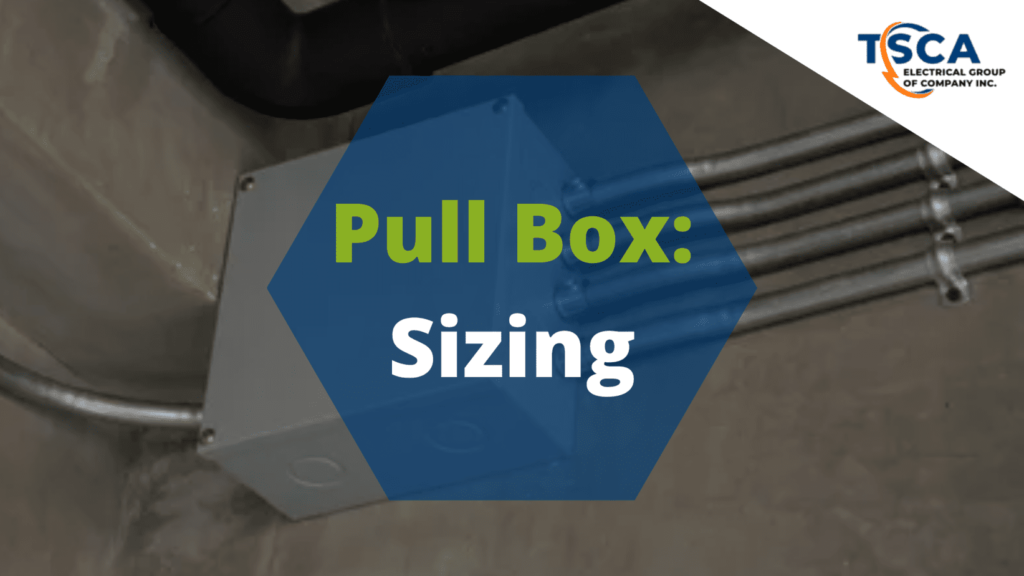Pull Box – are used along with conduit to simplify wiring installation, hence their name. They are made of sheet metal, cast metal, or a non-metallic material, and provide a way to pull conductors long distances without placing excessive strain on the wire or insulation. Pull boxes allow long wiring runs to be installed in shorter intervals, and can be used for both straight and angled pulls.
Pull Box
Pull box sizing is based on the size and number of conductors, as well as the number of raceways and their diameter. For conductors 4 AWG and larger, pull boxes and junction boxes must be sized in accordance with NEC article 314.28. This post will provide further overview of the sizing rules for the most common types of pulls, along with a calculation example.
Straight Pulls | Pull Box
In straight pulls, conduit enters and leaves on opposite sides of the box. Furthermore, the depth of a box for a straight pull is determined by the size of the largest conduit and by space required by locknuts and bushings. On the other hand, the pull box length must be at least eight times the diameter of the largest conduit:
- Assume a pull box has four conduit runs, and the largest diameter is 4”
- Minimum box length = 8 x 4” = 32”
Angle Pulls and U-Pulls | Pull Box
Boxes and conduit bodies containing conductors 4 AWG or larger, and containing angle or U-pulls must be sized in accordance with the specifications of NEC article 314.28(A)(2).
Angle Pulls
For angle pulls, the distance between each raceway entry inside the box and the opposite wall of the box must be the sum of the following:
- Six times the trade size of the largest raceway in a row.
- The sum of the diameters of all other raceway entries in the row.
Assume a pull box has a 90° turn with three raceways, with diameters 4”, 2” and 2”. Moreover, the calculation procedure would be as follows:
- Six times the largest raceway diameter = 6 x 4” = 24”
- The sum of all the other raceway diameters = 2” + 2” = 4”
- Total = 24” + 4” = 28”
In addition, the straight distance between the entry and exit points of each circuit must be six times the respective conduit diameter. In the example above, the required separations are:
- Separation for circuits in 4” conduit = 6 x 4” = 24”
- Separation for circuits in 2” conduit = 6 x 2” = 12”
U-Pulls
When conductors enter and leave from the same wall, the distance from where the raceways enter to the opposite wall is calculated with the same procedure used for angle turns:
- Six times the trade size of the largest raceway in a row.
- The sum of diameters for all other raceways on the same wall and row.
Note that the entry and exit points are counted separately for each conductor run. If a circuit uses 3” conduit and uses a pull box for a U-turn, the procedure is as follows:
- Six times the largest raceway diameter = 6 x 3” = 18”
- The sum of all the other raceway diameters = 3”
- Total = 18” + 3” = 21”
The straight-line distance between the entry and exit point is just like in angle turns: six times the conduit diameter. Furthermore, as shown in the example above, the required separation is 18” (6 x 3”).
Importance of the Design Procedure
While pull boxes are convenient, keep in mind that they require materials and labor, and can increase project cost if used excessively. The best recommendation is to hire a qualified design firm to optimize the electrical layout, ensuring that pull boxes are only used where necessary.
Energy efficiency also helps optimize electrical installation costs. A lower load requires smaller wiring, which in turn uses smaller smaller conduit diameters and accessories. The price difference may not be much for a single circuit, but it quickly adds up in a large project such as a high-rise building.
—
Thanks for reading Pull Box Sizing, visit our blog page for more articles. We would love to hear about your electrical needs. Furthermore, please feel free to email or call us. Someone from our team will respond to your request right away. Feel free to Contact Us.
Source(s): https://www.ny-engineers.com





